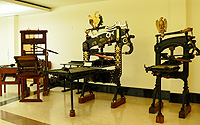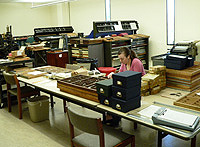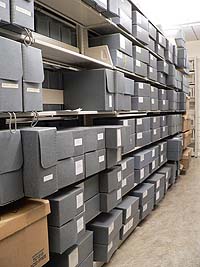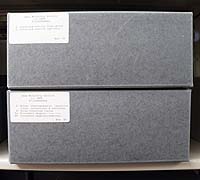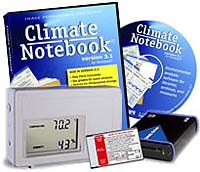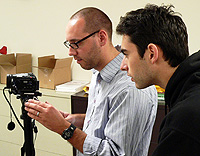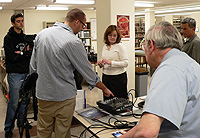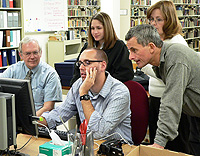January 8, 2007
Research of TH dataloggers and literature about environment monitoring for libraries and archives: on-line resources -- A tour of the Special Collections for the students in SLIS program: initial inquiry.
There are some articles and resource pages on the Internet dealing with the environmental monitoring equipment and environment control for archival purposes, but not as much as I expected:
- Conservation OnLine: Environmental Monitoring and Control resource page;
- Massachusetts Board of Library Commissioners: Environmental Monitoring;
- Solinet: Environmental Specifications for the Storage of Library & Archival Materials;
- National Park Service, Conserve O Gram: Datalogger Applications in Monitoring The Museum Environment, Part I: Comparison Of Temperature And Relative Humidity Dataloggers.
Because I could not find any information about the recommended number of dataloggers for a given space, I decided to post that question on The Archives & Archivist (A&A) listserv.
Even before I started this practicum, I thought that the Special Collections at UCR would be an interesting site for one of LISSTEN library tours. LISSTEN is an acronym for Library and Information Science Students to Encourage Networking, an networking organization of SLIS students. The rare and unusual books are always interesting, but antique printing presses and a printshop are something very special. However, the Special Collections are open only during the weekdays, 9:00 to 5:00 pm, and most of the students prefer weekend tours.
January 10, 2007
Meeting with Chuck Wilson, the UCR archivist -- Archival assignment: the Anne McCaffrey Papers -- A tour of the Special Collections Archives.
I met with Chuck Wilson, the UCR university archivist, who will advise and supervise my work on an archival collection. He just recently came to that position; before that, he was an archivist at UCLA. He is an active member of the Society of California Archivists (chairman of SCA Awards Committee), California Council for the Promotion of History (and so on) ...
Ms. Davis and Mr. Wilson decided that, during my internship, I will process the Annie McCaffrey Collection. The collection was stored in the archival part of the Special Collections which is in the back of the main stack room. On our way there, we passed shelves and shelves of books, gray archival boxes, brown (but apparently acid free) storage boxes, until we reached the shelves with McCaffrey collection. My assignment will be to:
- Research life and authorship of Anne McCaffrey;
- Propose series cataloging fields and series organization;
- Catalog the collection using MS Access;
- Process the whole collection according to the best archival standards;
- Write finding aid for the collection.
January 12, 2007
Review of the available collection acquisition documentation -- Previous processing information: typed box list of part of the collection -- The report on dataloggers -- Technical preparation for the Authors Series: equipment testing.
Anne McCaffrey donated material associated with her books on two occasions. According the collection documentation -- mostly the correspondence between Sidney E. Berger, previous Special Collection librarian, and Anne McCaffrey -- the first donation took some time to arrive. In October of 1992, McCaffrey send her papers by ship to Los Angeles, where the university custom broker should receive them and arrange for them to go through customs. For some reason the agent neglected the shipment until January of 1993, at which point a freight company sent message to McCaffrey threateningly to auction off her papers unless she pays the storage fee. Furious, McCaffrey sent off faxes: one to the agent threatening to sue him and his company for everything they are worth, and one to Berger asking what hell is going on. It took some time before Berger managed to straighten things out, pay fees, get the shipment delivered and arrange for the agent's company to be dropped off the University contractor's list. This part of the donation was partially processed and a container list was compiled, by Jazmyn, a fan of McCaffrey's books. However the collection was never fully cataloged. The container list exists only in paper form.
In 1995, Virginia Kidd, McCaffrey's literary agent, at the instruction of McCaffrey, donated book production material for the book Freedom’s Landing. However, there was material in the collection that was not listed on any of documents and there are no paper trail how it find its way to the Special Collections. The second part of the donation was only partially processed, but no inventory list was ever compiled.
I submitted my dataloggers research report. Main conclusions:
- The overview and list of the dataloggers was based primarily on price and technical specifications, not the accompanying software.
- Most of the manufacturers provide extensive technical information while software is usually described in very general (and glowing) terms. It is quite difficult to find common denominators to compare.
- All that can be said is, that they all have software that enables an upload of data to a computer and presentation of that data in the form of a chart or table.
- The notable exception is the Image Permanence Institute, since, their software (and datalogger) was developed “specifically for preservation use in cultural institutions” (PEM Operator’s Manual) so that it is not really comparable with others in scope and price.
- It is hard to say how many sampling stations would be necessary to comprehensively monitor storage space in UCR Special Library. There are no formulas giving a datalogger/space ratio.
- At this point it is estimated that the Special Collections will need a minimum number of three (3) sampling stations: one in the vault and two in main shelving area.
Total: 20 hours
Links:
:: Solinet Preservation Publications
Old presses all in working order, exhibited in the main reading room, the Special Collections, UCR.
The Special Collections, UCR, printshop. Most of the equipment is donated by Dr. Edward Petko.

A line of type set in a composing stick.
Total: 25 hours
Links:
:: Society of California Archivists
Shelves with the McCaffrey Papers, before processing.
Total: 33 hours
Links:
:: McCaffrey bibliography (ISFDB)
PEM datalogger and environmental monitoring software from Image Permanence Institute.
Eric Milenkiewic, public service supervisor & reference assistant (and SLIS student) and one of students working in the library are testing a digital video camera.
The Special Collection staff working out details of sound and video recording for upcoming lectures series.
Modern technology always needs a full quorum to function properly ...
Text, design, photographs and
digital imaging by Vlasta Radan.
Last update May 25, 2007.
